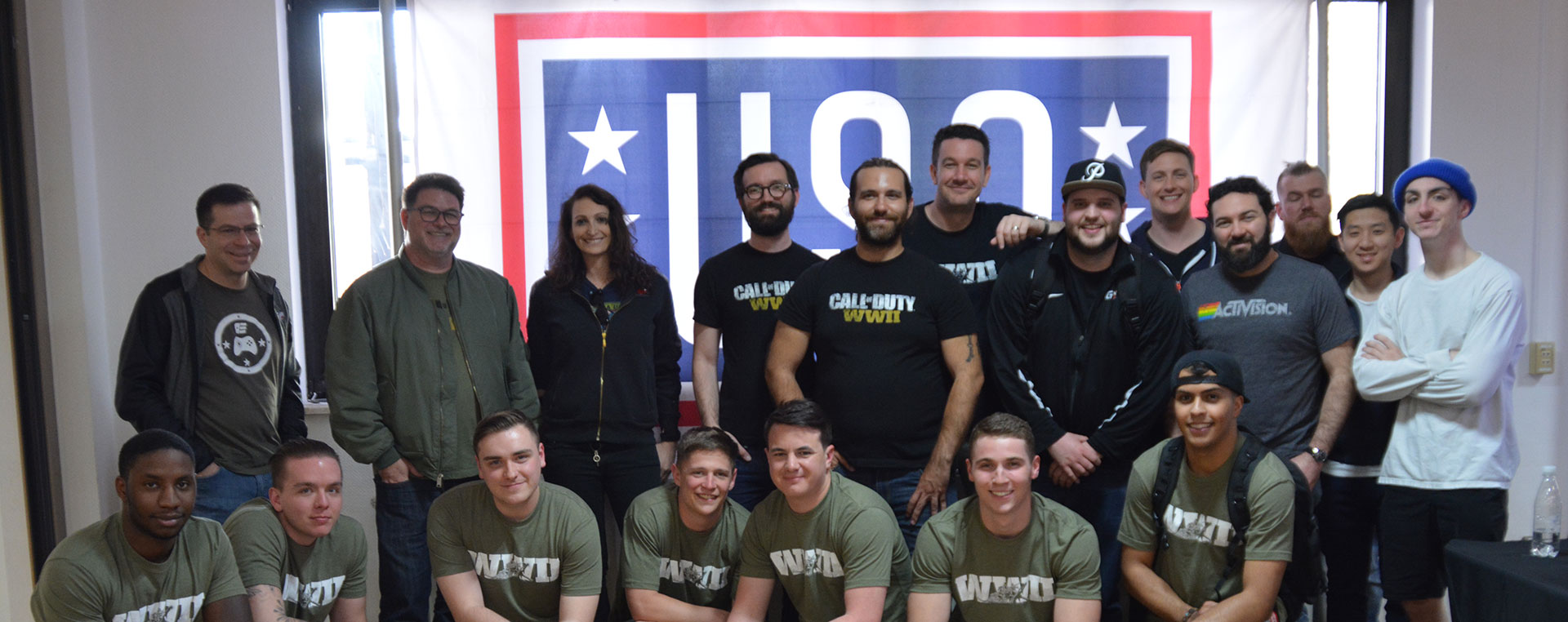Members of the Call of Duty team from Activision and Sledgehammer Games recently had the honor of meeting service members in our armed forces who are stationed overseas in Germany and Kuwait. Keep reading to follow the event of the tour and find out what it was like to meet the real heroes in uniform.
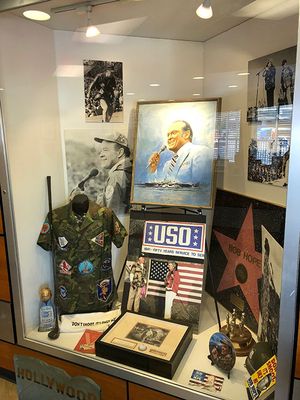 I’m standing inside the Bob Hope Hollywood USO inside Los Angeles International Airport, and I’m looking at a glass display case near the entrance that contains pieces of memorabilia, including a Marine uniform worn by Hope during one of his 57 USO tours. It’s a historic touchstone that gives me pause, as Activision and Call of Duty are about to embark on their very first official USO tour to meet active duty service members stationed in Germany and Kuwait.
I’m standing inside the Bob Hope Hollywood USO inside Los Angeles International Airport, and I’m looking at a glass display case near the entrance that contains pieces of memorabilia, including a Marine uniform worn by Hope during one of his 57 USO tours. It’s a historic touchstone that gives me pause, as Activision and Call of Duty are about to embark on their very first official USO tour to meet active duty service members stationed in Germany and Kuwait.
This landmark tour will bring us into direct contact with the service members who put their lives on the line on a daily basis, far away from home, to safeguard our home country and our way of life. These men and women are the real heroes, and we owe them a debt that we can never repay.
Inside the USO center, I meet up with Dan Goldenberg, the Executive Director of the Call of Duty™ Endowment who has also served 25 years of active and reserve military duty and counting. Dan has just finished touring the new facility for the Bob Hope USO, which will open inside LAX this summer. We meet several veterans working inside the USO who wish us well on our tour and let us know how excited the service members will be to see us. After saying our goodbyes, we head off for the long flight to Frankfurt.
We arrive at Frankfurt the next morning to meet up with the rest of our group and immediately board a bus for the two-hour ride to Ramstein Air Base. This facility serves as the headquarters for the United States Air Forces in Europe – Air Forces Africa, and for the NATO Allied Air Command. It was originally built in 1948 and has been in active service since 1952. Ramstein Air Base is also part of the Kaiserslautern Military Community, which consists of 54,000 people, including service members, Department of Defense civilians, contractors, and their families, and is the largest military community outside of the United States.
After checking into the Air Force Inn, an on-base hotel facility that houses active duty service members as well as sponsored guests, we head to dinner and meet key members of the USO team stationed in Germany to go over the plan for our first event. Joining us at dinner are several USO volunteers, who are actually off-duty service members, and all of them are extremely excited to have us visit. Conversation at dinner is very animated and continually returns to the head to head setup that has been prepared for that night. There is a lot of excitement in the air about this tour, and people are itching to play Call of Duty: WWII.
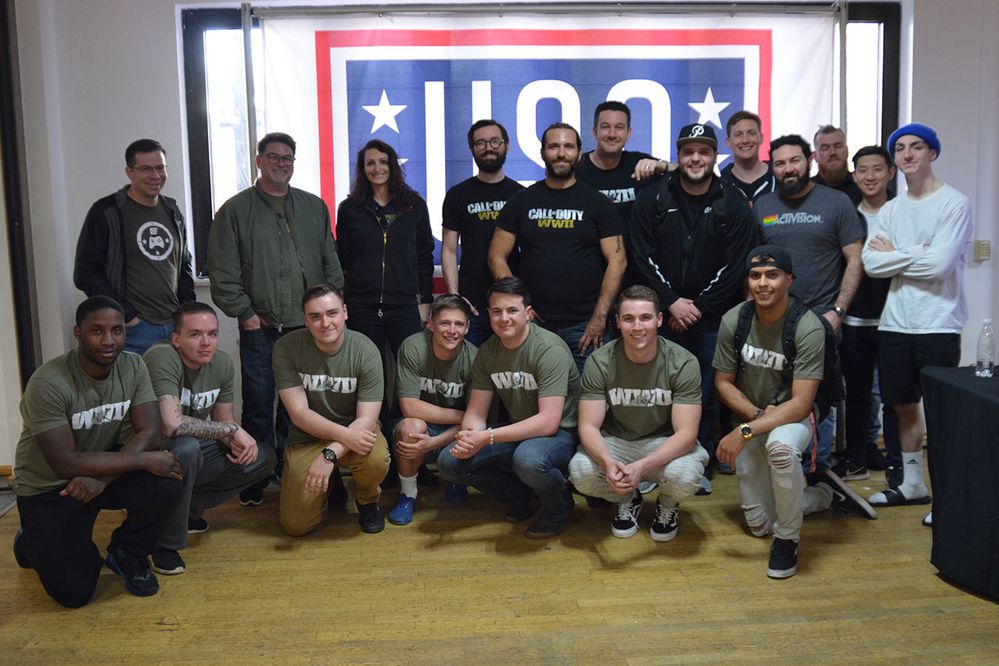
After dinner, we head to the Ramstein Community Center, where two 6v6 areas have been set up by our production team. An eager group of service members, both in and out of uniform, have already lined up and are excited to grab the sticks and start playing. After a brief introduction from Sledgehammer Games Communications and Brand Strategist Brian Miggels, including a video full of positive messages from the team back at Sledgehammer Game’s headquarters in Foster City, California, and a word from Dan Goldenberg, the competition gets underway.
The service members instantly take to the competitive environment and gameplay experience as they play Call of Duty: WWII - The War Machine DLC pack for the first time. The air is filled with friendly trash talk, and because the multiplayer stations are labeled with generic names like Able Five, Baker Three and so on, we quickly hear rallying cries of “IN YOUR FACE, BAKER SIX!” or “YEAH ABLE FOUR WITH THE TRIPLE!” In short, the atmosphere is electric.
The next day, after a much-needed night of sleep, we are extremely lucky and honored to be able to visit two working military units on the base and to receive demonstrations from each of them. First up is the 86th Civil Engineer Squadron Explosive Ordnance Disposal Flight. These are the brave airmen who suit up in bomb disposal gear, sweep for mines, pilot remotely operated robots, and continually train to be able to handle dangerous material and defuse them.
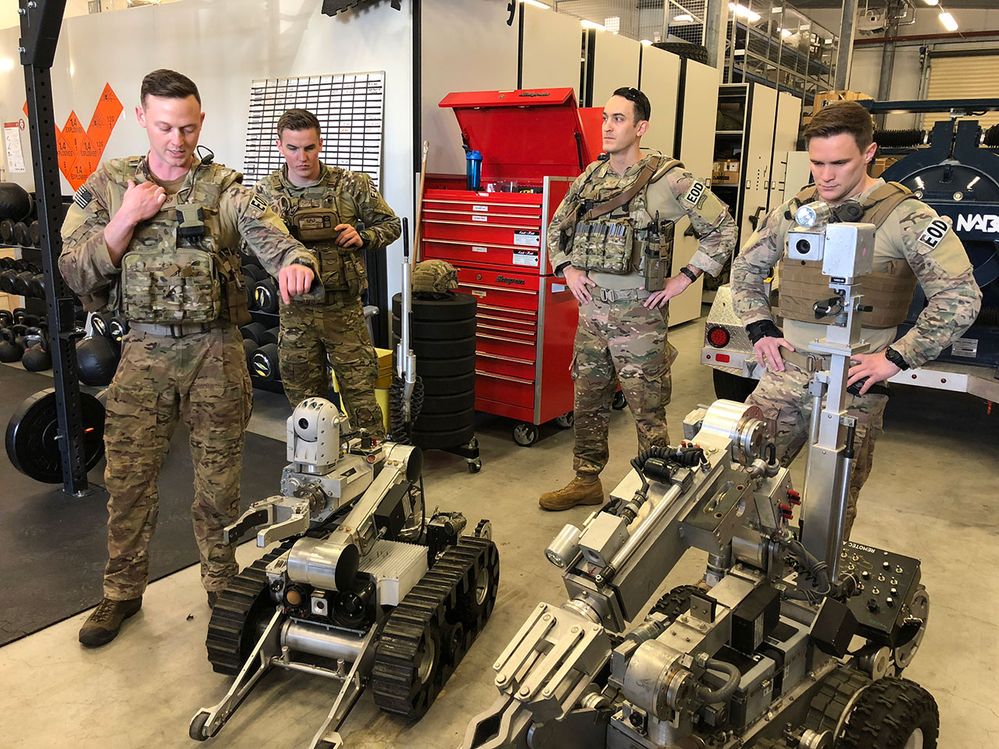
Inside their conference room is a vast array of sample explosive devices, and they give us the opportunity to run through a scenario where someone has to deactivate a laser tripwire and rescue a hostage. We manage to do this, but only after much coaching from the EOD techs and several “resets,” which is something that doesn’t happen in the field.
These are the service members who encounter the Improvised Explosive Devices and then defuse them, putting their lives on the line every mission and it is an awe-inspiring thing to watch them work. Just outside the main room sits a memorial to their comrades who have fallen, which is a sobering reminder of the dangers they face on a daily basis, and how strong the bonds of the uniform are.
Next, we head over to the 86th Security Forces Squadron Military Working Dog Section. This section trains and operates a group of military working dogs who are each trained to work with their handler as a single unit, and they are used as drug and bomb-sniffing dogs, rescue dogs, scout dogs, as well as for their ability to take down perpetrators with extreme aggression. Which just happens to be the demonstration they have lined up for us.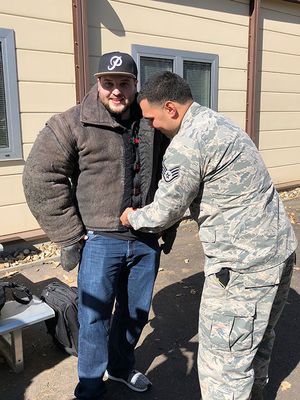
Jordan “LEGIQN” Payton, the YouTube personality who is a part of our tour group, is the lucky volunteer. He straps on a protective padded suit, runs across the training grounds and has a German Shepherd dispatched after him. In mere seconds, the dog is attached to his arm. The dog releases him at a command from its handler and goes immediately back to attention.
It is extremely impressive to see these dogs work in tandem with their handlers, and you definitely wouldn’t want to be on the receiving end of those teeth. This section not only handles the dogs and training for Ramstein Air Base itself but also takes care of 400 to 500 dogs and handlers that head “downrange” in the region, military language for being deployed overseas, usually in a war zone. They drill just as hard as the humans in uniform, and the demonstration has been another standout experience on this tour.
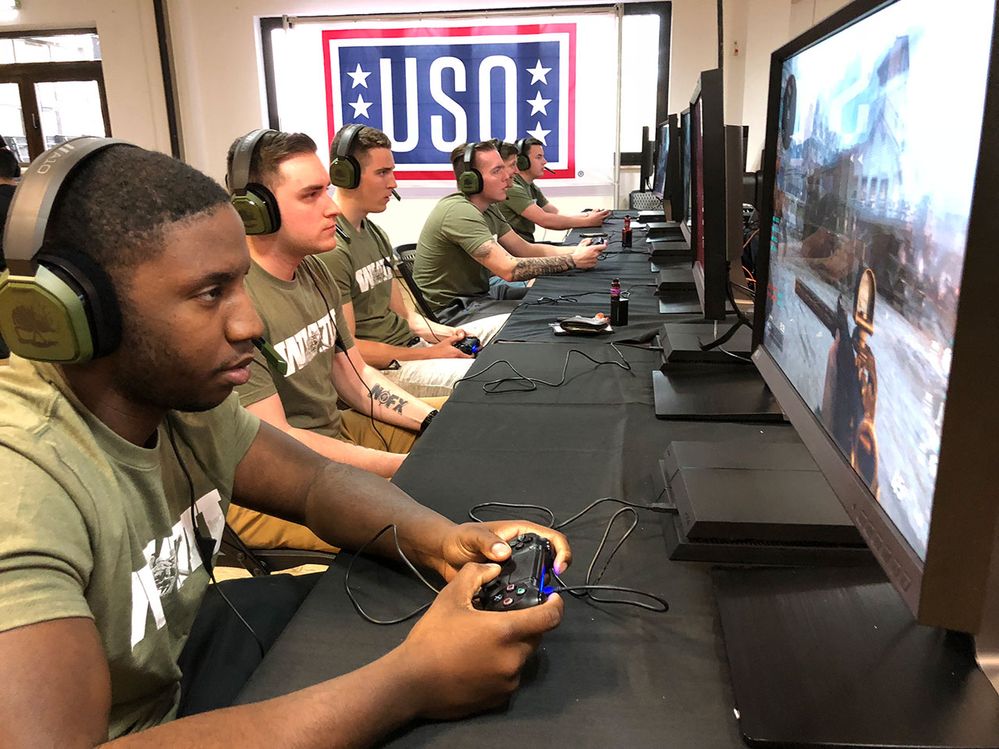
After wrapping up time with these two working units and handing out Call of Duty: WWII and Call of Duty Endowment challenge coins to service members, we head back to the Community Center for another night of gameplay. By now, word has spread about the previous night’s competition. Some of the more boisterous Ables and Bakers from the night before have returned, bringing friendlier trash talk, and end-game celebrations worthy of anyone’s attention. Being able to give these service members a break, even a brief one, from their everyday duties is very satisfying, and is just one small way we can give back to them.
Early the next morning, we pack our bags and head back to the Frankfurt Airport to depart for Kuwait. Our destination is Kuwait City, and then ultimately the Area Support Group – Kuwait. The ASG-KU is responsible for the security and life support operations for three base camps in Kuwait – Camp Arifjan, Camp Buehring, and Kuwait Naval Base. These camps house thousands of Active Duty service members, deployed reservists and National Guard units, contractors, and their families who work together to facilitate logistical operations throughout the Kuwait Theater of Operations.
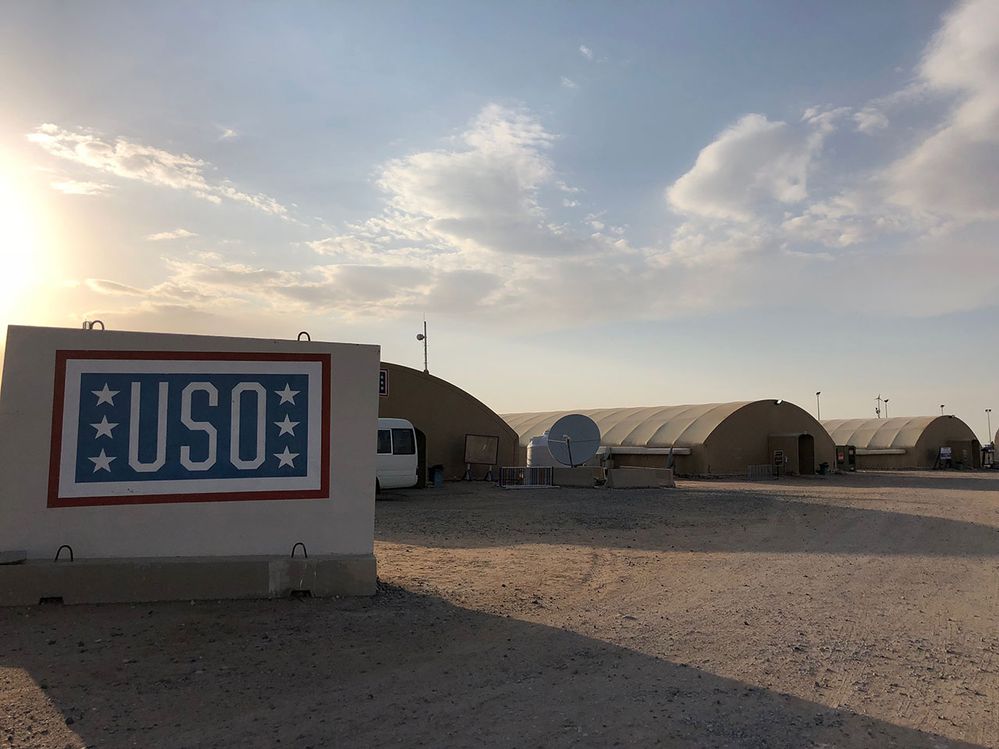
Our first stop is Camp Buehring, which is a staging post for US troops in the northwestern region of Kuwait. Originally opened in 2003 as Camp Udairi, it was renamed in 2004 in honor of Lieutenant Colonel Charles H. Buehring who was killed in Baghdad. The camp is located in a region that is largely uninhabited, outside of nomadic Bedouin tribes who raise camels, goats, and sheep. Sure enough, just before we reach the gates of the camp, we encounter a herd of camels leisurely crossing the street. While Ramstein was located near a large city with plenty of nearby restaurants, a shopping mall, and permanent buildings, Camp Buehring is truly in the middle of a desolate desert.
Inside Camp Buehring, we are honored with an invitation to a Commander’s Call, with Lieutenant Colonel Katie Matthew, who is the officer in charge of Camp Buehring. She has been joined by several of her officers who are eager to hear more about the planned our visit.
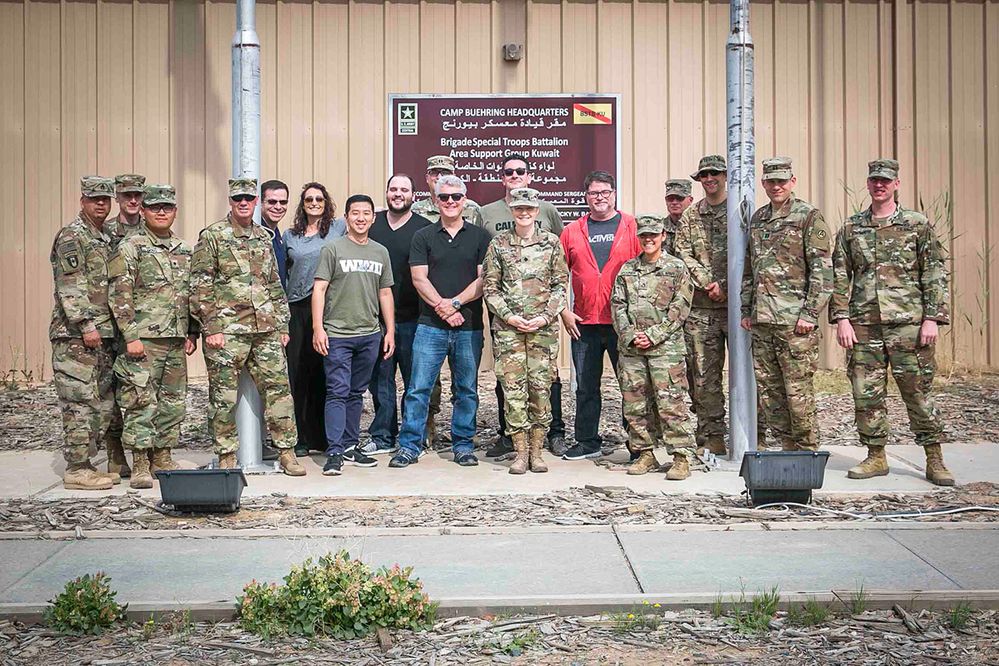
The Buehring officers introduce themselves to us, and we do the same in return. After a short Q&A session with questions asked on both sides (“What was it like going back to WWII for Call of Duty?”, “Are the soldiers at this camp able to play games that often?”), the Lt. Colonel presents each of us with a plaque thanking us for our visit. It is a truly humbling moment, during which I nearly lose my composure completely. Here are these service members, sacrificing time with their friends and family, and the comfort of their own homes to safeguard us on a daily basis for weeks, months, years at a time… and they are thanking us. It is a remarkably humbling moment, and we all make sure to thank them for their service and everything they do.
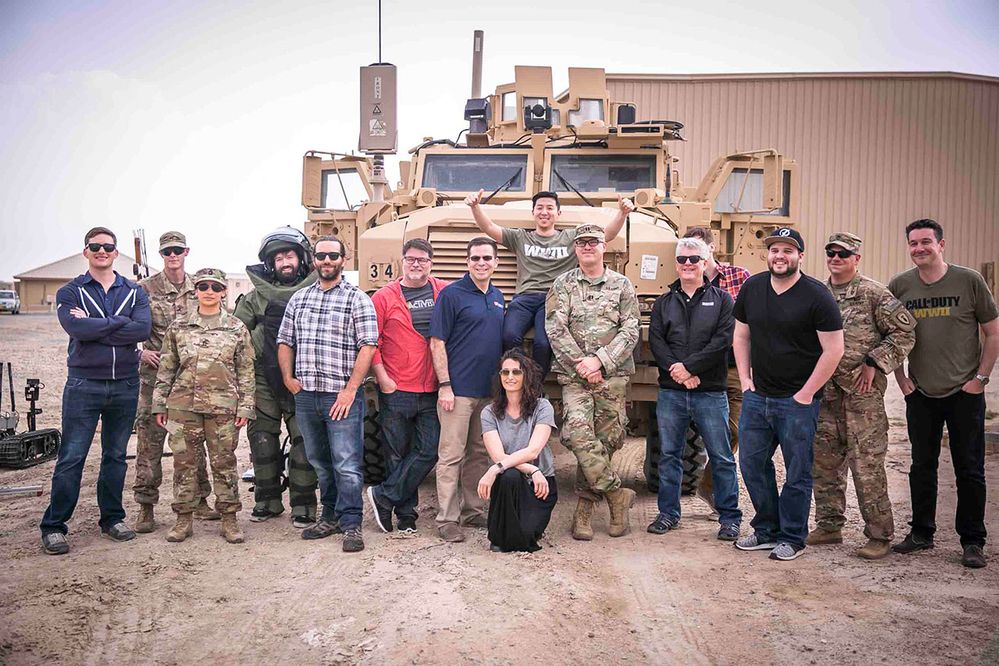
After the Commander’s Call, we have lunch in the mess hall with service members from all over the camp. Then we head off to another unit visit, this time to the Army Explosive Ordnance Detail stationed at Camp Buehring. While this team has a bomb disposal suit identical to the unit at Ramstein, they also have an RG-33 Medium Mine Protected Vehicle EOD, also known as the Panther. This 60,000-pound, thickly armored vehicle is 30 feet long and over 11 feet high and can withstand the blast from an improvised explosive device due to its “V-shaped” undercarriage. The EOD variant can carry several soldiers along with racks of gear and is a total behemoth.
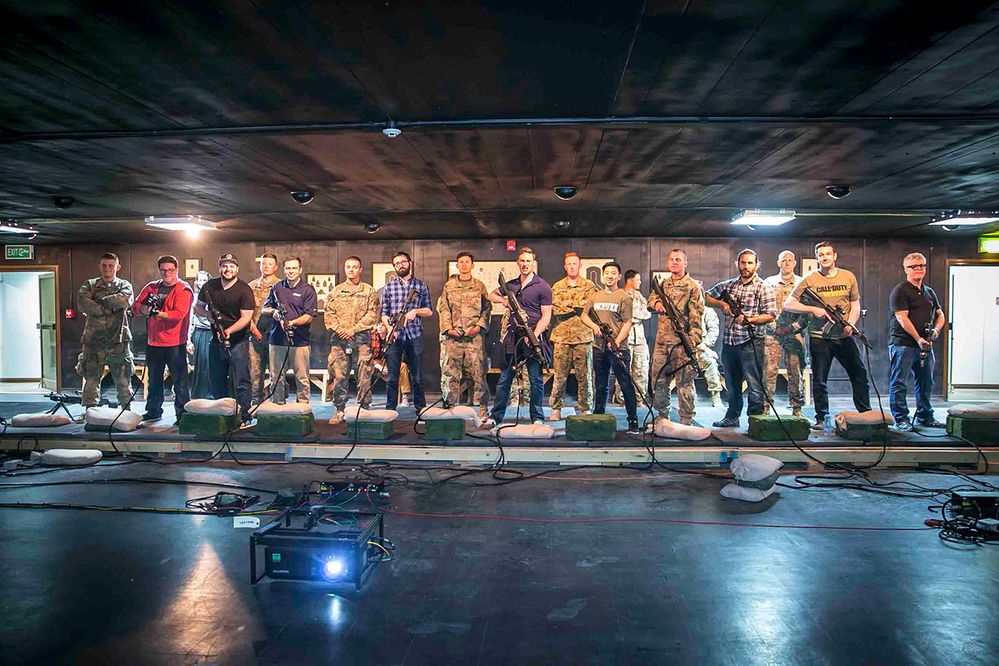
From there, we step inside a darkened structure that houses an Engagement Skills Trainer, which functions as a digital firing range. This system utilizes actual weapons that have been modified to work with a virtual environment. You insert an (empty) magazine into the weapon, and then lock and load normally. The system registers a full clip, and the gun will kick, and the bolt will ‘fire’ in your weapon as if it is loaded with actual ammunition.
While this experience is just a simulation, after just a few minutes it is obvious just how hard these exercises are. The weapons are heavy, and maintaining your posture, firing, reloading, and continuing to call out and scan for hostiles is challenging. Plus, we have the added advantage of being in an air-conditioned tent, with each of us partnered with a soldier to keep us on task. It illustrates the physicality of these service members, and how cool they have to be while under duress.
Afterward, it’s time to head to the USO Center at Camp Buehring. The center is bustling with activity, as service members do everything from reading books to video chatting with family back home to playing video games and even practicing with musical instruments in a soundproof music room. While the barren sands of the desert are literally right outside the door, the inside of the USO center is teeming with life and options to connect to family, home, and country.
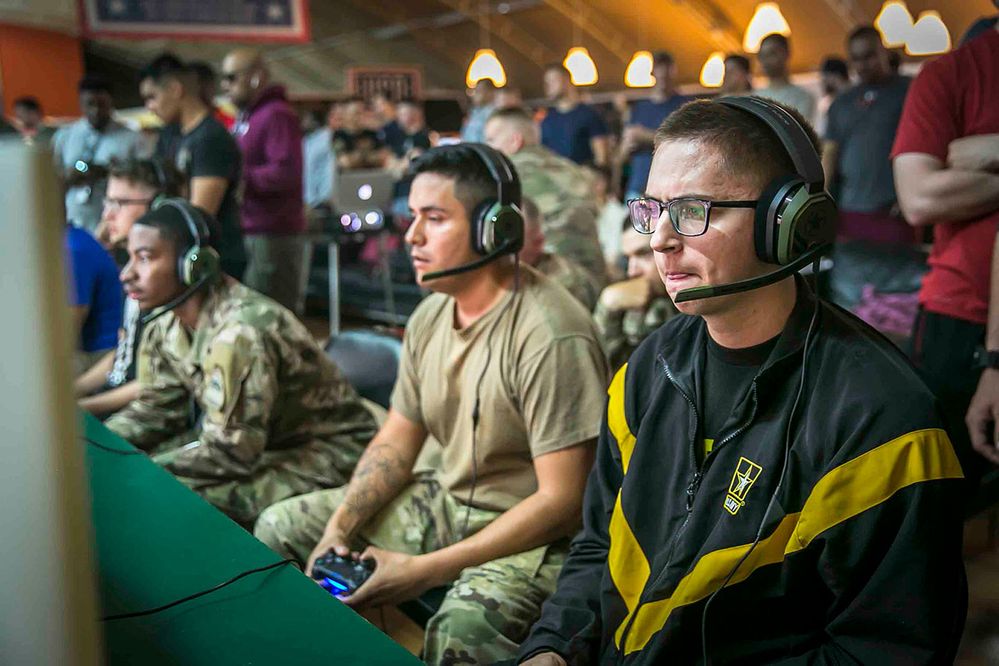
Tonight, a very large crowd of service members have gathered around the Call of Duty: WWII stations that have been set up again in two sets of 6v6. This is an extremely hyped group who have gathered to check out the new DLC and compete, and all of them have brought their A game. The competition is fierce and intense, and once again when teams triumph, the crowd erupts into deafening cheers. The games continue until late into the night, and after the conclusion of a particularly epic Hardpoint match, we reluctantly say goodbye to the service members and depart Camp Buehring.
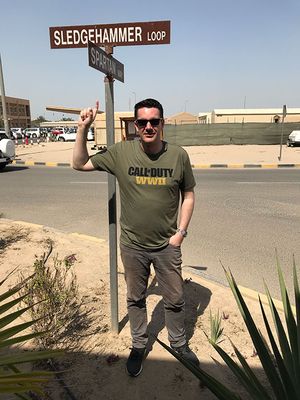 The following day, we leave early for Camp Arifjan. Construction on this camp began in 1999, and where Camp Buehring felt like an installation that could pack and move quickly if need be, Camp Arifjan feels more settled. There are permanent buildings in place, such as a swimming facility and three gyms, as well as many support buildings throughout the Camp. Paved roads complete with street signs snake around the facility (including a “Sledgehammer Loop”!), and there is even a patch of live grass in front of the Commander’s offices. This vibrant splash of green in a vast sea of sand is a point of pride for the base, and is adorned with an enormous concrete A inside a blue field and encircled with red, the symbol for Patton’s Third Army, which is alive and well today!
The following day, we leave early for Camp Arifjan. Construction on this camp began in 1999, and where Camp Buehring felt like an installation that could pack and move quickly if need be, Camp Arifjan feels more settled. There are permanent buildings in place, such as a swimming facility and three gyms, as well as many support buildings throughout the Camp. Paved roads complete with street signs snake around the facility (including a “Sledgehammer Loop”!), and there is even a patch of live grass in front of the Commander’s offices. This vibrant splash of green in a vast sea of sand is a point of pride for the base, and is adorned with an enormous concrete A inside a blue field and encircled with red, the symbol for Patton’s Third Army, which is alive and well today!
Our first destination is another Commander’s Call, this time with Colonel Steven R. Berger who handles all of Camp Arifjan. At least 50 uniformed soldiers are present and at attention as we walk in with the Colonel, and it is an intimidating sight to behold.
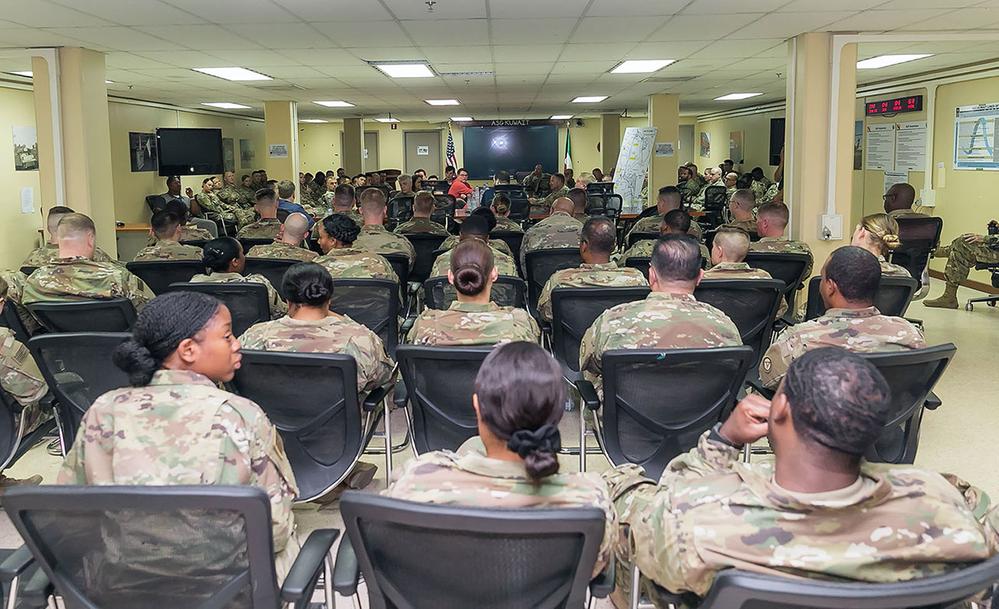
As with the Call in Camp Buehring, we each stand up and introduce ourselves and say a few brief words, and when the time comes for me to talk, I stress how thankful that we and everyone at Activision are for their service. These words catch in my throat as the emotion again wells up, seeing these eager service members turning up in such large numbers to meet with us. Somehow, I manage to finally get the words out, and the Colonel opens things up to a Q&A, where we field questions about everything from working at Activision to the design of Call of Duty: WWII.
From there, we head to the mess hall to have lunch with service members before heading to our next unit visit. First up is a visit to their Military Police building, where a group of MPs take us through a room clearing exercise and explain what they do to as part of their daily duties.
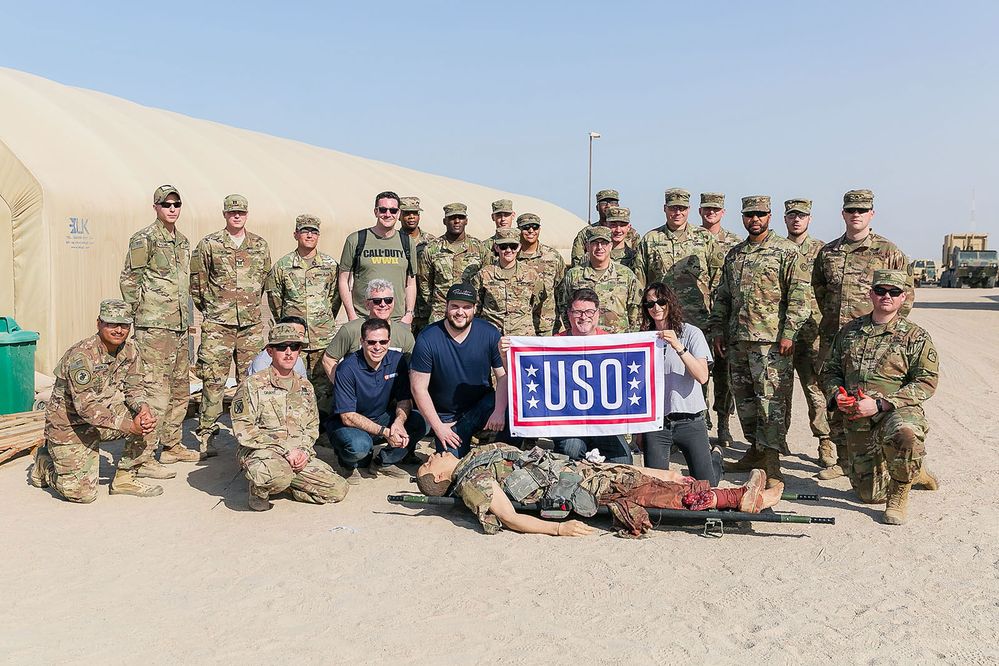
After that, we head to the medical training facility, where we are shown trauma care with the aid of a $125,000 mannequin that breathes, moves, bleeds, and has a pulse. With this incredibly lifelike (and creepy) tool at our disposal, we learn how to seal bullet wounds, staunch arterial bleeding, and restore breathing. Which are just a few of the medical procedures that can be addressed in the field by this unit. Afterward, we head outside for some simulated .50 caliber machine gun fire and mortar rounds, which are additional tools that the medical unit utilizes to stress test trauma care while under fire.
Our last stop of the tour is the USO Center at Camp Arifjan. We have a few moments to ourselves outside as the sun sets on the Camp and before the evening’s activities begin. I use this time to reflect back on this whirlwind tour, which has truly been a life-changing experience. To be able to travel to where our service members are stationed, and to interact with them, watch and learn what they do, and to help take their minds off of all that, even if just for a few minutes has definitely been one of the most humbling and rewarding moments in my career.
Before long, it’s go time and we head into the center to fine-tune the gaming setups for the night right before the show begins. Another rowdy group has shown up to compete, and the air is filled with cheers, laughter, trash talk, and the sounds of Call of Duty. Even Colonel Berger stops by to survey the scene and watch his men and women play. There are several moments where I find myself swept away watching the competition unfold on the screens and seeing service members erupt in smiles and handshakes after each match completes.
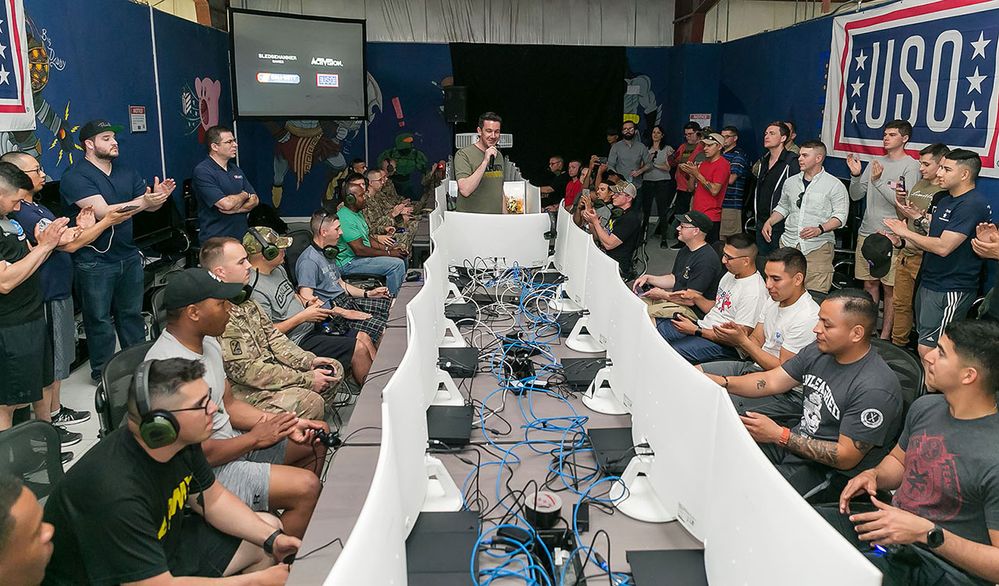
We remain at Arifjan until late in the evening, and then we get bussed back to our hotel to collect our bags before departing to the airport. The remaining two hours fly by quickly, and in the blink of an eye, our small group is scattered, flying back on different flights. In many ways, it feels like we had only arrived the day before, and throughout the trip home, I reflect on what I’ve been able to see and experience in the past few days. While the opportunity to travel to new places is not lost on me, it’s service members that I’ve been able to meet and speak with that have had the most impact. Everyone we met thanked us for coming over there, and that above all has really stayed with me the most.
I am extremely grateful to both Activision and Call of Duty for this experience, which is not something I ever dreamed about being able to do. I would like to thank all the service members in the United States Armed Forces, as well as their families, for their sacrifices and for everything that they do. You do us proud every day.
Thank you to Activision and the USO for making this trip possible. To find out more about the Call of Duty Endowment and how you can help support veterans, please visit their website. For more information about the United Service Organization and how you can get involved, please visit the USO website.

